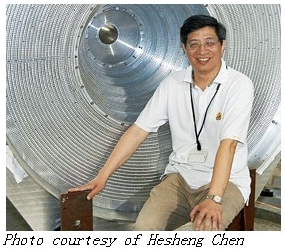commentary: hesheng chen
 Golden opportunities in China
Golden opportunities in China
Although collaborations are still modest, golden physics opportunities exist in China, such as the BESIII experiment at BEPC-II (the upgraded Beijing Electron-Positron Collider) and the Daya Bay Reactor Neutrino Experiment. Realizing those excellent opportunities, the People's Republic of China-United States Joint Committee for Cooperation in High Energy Physics decided at its last meeting to sponsor and organize a workshop to discuss how to further the PRC-US cooperation in high-energy physics. The Institute of High Energy Physics will host the workshop from June 11-18, 2006, in Beijing, at which the current status of the Chinese high-energy physics programs will be reviewed with emphasis on how to fully tap the physics potentials of the above-mentioned experiments and opportunities by increased collaboration. Concrete proposals to strengthen the PRC-US collaboration in high-energy physics are expected to follow the workshop.
The BEPC-II collider operates at the tau-charm energy region (energy range: 2.0-4.2 GeV) with a design luminosity a factor of 100 greater than the previous, successful BEPC. The upgrade will use the existing tunnel, major infrastructure, and some of the old components, such as magnets. The new linac was installed last summer and has met most of the design specifications so far. Major components, such as magnets, superconducting radiofrequency cavities (via cooperation with KEK and MELCO in Japan), quadrupole magnets (via cooperation with Brookhaven National Laboratory (BNL)), and the cryogenic system, are complete. The beamline installation is under way; tuning will start by September 2006. The BESIII detector will contain much-improved components over its previous design and will be moved into place by summer next year; data taking should begin by fall 2007.
Last January, the BESIII collaboration reviewed construction status and discussed technical details in a meeting at IHEP-Beijing. More than one hundred collaborators attended from five countries and 21 institutions, including the University of Science and Technology of China, Peking University, Tsinghua University, Shandong University, University of Hawaii, University of Washington, University of Tokyo, and the Joint Institute for Nuclear Research (JINR) in Russia. The collaboration accepted new members, including Gesellschaft für Schwerionenforschung (GSI), University of Bochum, and University of Giessen from Germany. The workshop "Charm 2006," to be held from June 5-7 at IHEP-Beijing, will discuss the physics potentials of BESIII.
The Daya Bay Nuclear Power Complex is 50 km from Hong Kong. It has two groups of reactors with a total thermal power of 11.6 GW, which will be increased to 17.4 GW by 2011, the second most powerful nuclear power plant in the world. The complex is close to mountains that are suitable for tunneling. We believe that Daya Bay is the best site in the world for a reactor neutrino experiment to measure sin2(2θ13). We plan to build two near detectors, one for each reactor group, and a far detector located at about 2 km from the reactor groups.
The Chinese funding agencies have agreed to support the experiment. The China Guangdong Nuclear Power Co., the owner of the Daya Bay complex, supports the proposal and has approved the feasibility report on the experimental tunnel.
The Daya Bay Reactor Neutrino Experiment collaboration was formed last February with 10 institutions from China, Lawrence Berkeley National Laboratory, BNL, and five universities from the United States, as well as JINR and Kuchatof from Russia. The collaboration has carried out extensive detector R&D and simulation studies. The proposal will soon be ready, and tunnel construction is expected to start in early 2007. The commissioning of the experiment will be in 2010.
China also conducts observations at the Yangbajing Cosmic Ray Observatory in Tibet and will launch the hard X-ray modulator telescope satellite to search for point sources by 2010. We look forward to many exciting physics projects in collaboration with scientists from around the world. Hesheng Chen Hesheng Chen is the director of the Institute of High Energy Physics, Beijing, China.